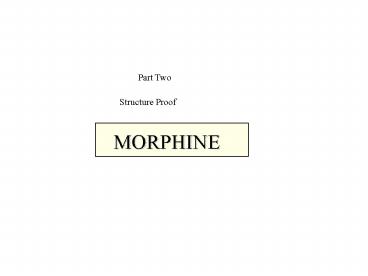MORPHINE PowerPoint PPT Presentation
1 / 25
Title: MORPHINE
1
Part Two
Structure Proof
MORPHINE
2
MUCH OF THE WORK WAS DONE ON CODEINE
morphine
codeine
C17H19NO3
C18H21NO3
MeOH
aD - 136.0o
mp 254o
mp 155o
pKa 8.2
pKa 8.87
3
PRELIMINARY WORK
codeine
4
PRELIMINARY RESULTS
no FeCl3 test
PhNMe3 OH-
morphine
codeine
C17H19NO3
C18H21NO3
aq FeCl3
Pd H2
CrO3 HOAc
u 9
u 9
colored solution
codeinone
dihydrocodeine
PHENOL
C18H19NO3
C18H23NO3
BrCN
von Braun
DOUBLE BOND
2o ALCOHOL
C18H18NO3 CH 3Br
H3O
C17H19NO3 CO2
3o AMINE (N-methyl)
5
INITIAL TRY AT PART-STRUCTURES
The results on the previous slide allow us to
draw part-structures for each of the compounds,
showing what we have found in each case.
MORPHINE
CODEINE
CODEINONE
methoxy- aromatic
phenol
2o alcohol
ketone
double bond
double bond
N-methyl (3o amine)
N-methyl (3o amine)
6
CONTINUED INVESTIGATION
CH3I NaOH
codeine
codeine methiodide
C18H21NO3
C19H23NO3 I-
adds once
Br2 CCl4
3o AMINE
AROMATIC SUBSTITUTION
bromocodeine
C18H20NO3Br
Only one ortho or para position is
available. Activated rings like anisole react
three times.
H2 Pd
bromodihydrocodeine
bromocodeine still has a double bond
C18H22NO3Br
2 atm H2 Pd
HYDROGENOLYSIS
C18H23NO3 HBr
7
CODEINE - THE MISSING OXYGEN
nitrogen atom
codeine
oxygen 1
C18H21NO3
oxygen 2
oxygen 3
CODEINE
not identified
The third oxygen was thought to be an ether
because of its inertness.
8
HOFMANN DEGRADATIONS
Codeine
9
HOFMANN DEGRADATIONS
codeine
Two Hofmann sequences were required to eliminiate
nitrogen. This implies the nitrogen is in a ring,
not in a chain or at a ring junction.
C18H21NO3
1. CH3I, NaOH 2. Ag2O 3. heat
an isomer
strong heating
a-codeimethine
b-codeimethine
C19H23NO3
C19H23NO3
1. CH3I, NaOH 2. Ag2O 3.
heat
1. CH3I, NaOH 2. Ag2O 3. heat
MYSTERY RESULT
should add to 20 carbons
methylmorphenol
If you do your accounting you will see that two
carbons were lost and not accounted for (in fact,
C2H4 is lost).
C18H21NO3
C15H10O2 (CH3)3N H2O
u 11
10
METHYLMORPHENOL
11
METHYLMORPHENOL
cleaves ether
CH3Br
positive FeCl3 test
negative FeCl3 test
H
Br-
HBr D
methylmorphenol
morphenol
C15H10O2
C14H8O2
a phenol
Zn dust distillation
Zn dust distillation
acetic anhydride
phenanthrene
monoacetate derivative
C14H10
identified by ultraviolet spectrum
Care must be taken, however, the following
rearrangement has been shown to take place.
this implies a phenanthrene-like skeleton
Zn
D
12
ULTRAVIOLET SPECTRA OF AROMATIC SYSTEMS
Aromatic ring systems have particularly
characteristic ultraviolet spectra. The fine
structure of a given ring type is very
identifiable by the wavelengths of both its
maxima and minima. Substituents have little
effect on the overall shape of the spectrum. It
is easy, for instance to tell the difference
between a system with a phenanthrene ring and one
with an anthracene ring. Other types of rings
are also easy to recognize.
13
PART STRUCTURE OF METHYLMORPHENOL
phenanthrene ring
OCH3
methylmorphenol
C15H10O2
oxygen 1
oxygen 1
UNKNOWN
not identified or located by ordinary chemical
reactions
OCH3
Because the second oxygen was so inert
to chemical change, it was postulated that it was
a diaromatic ether (not easily cleaved) located
at the notch between the two outer rings.
However, diaromatic ethers can be cleaved by
the reagent Na/EtOH (next slide)..
14
CLEAVING DIAROMATIC ETHERS
This can be accomplished by using a dissolving
metal reduction.
DIAROMATIC ETHERS
Na EtOH
The standard method of cleaving ethers (conc HI
or conc HBr) only works on aliphatic ethers or
ethers where one of the groups is aliphatic,
preferably primary. It is an SN2 reaction.
NOT HERE (sp2 carbon)
ALIPHATIC OR HALF-ALIPHATIC ETHERS
SN2 at the primary carbon
cleaves ether
CH3Br
H
Br-
CH3Br
Br-
15
METHYLMORPHENOL
TRYING TO FIND THAT DARN OXYGEN-2
conc HBr
FeCl3 (-)
FeCl3 ()
FeCl3 ()
Na EtOH
morphol
methylmorphenol
methylmorphol
C15H10O2
C15H12O2
C14H10O2
acetic anhydride
conc HBr
a diphenol
FeCl3 ()
monoacetyl- morphol
KOH 250o
morphenol
C14H8O2
acetic anhydride
CrO3
an acetyl- phenanthraquinone
monoacetyl- morphenol
CrO3
B
an acetyl- phenanthraquinone
assumed
A
16
PHENANTHRAQUINONE FORMATION
Phenanthrene rings are easily oxidized to
phenanthraquinones. The double bond in the middle
ring behaves like an ordinary double bond in
many reactions, not as if it were aromatic. The
9,10 double bond is very reactive.
10
9
CrO3
1
8
2
7
3
4
5
6
phenanthraquinone
Br2
If there is any substituent at either C9 or C10,
except OH, then the phenanthraquinone cannot
form.
Therefore, if a phenanthrene compound forms a
phenanthraquinone derivative, there is likely no
substituent at either C9 or C10.
17
IF WE ASSUME THIS STRUCTURE FOR
METHYLMORPHENOL THE RESULTS MAKE SENSE.
conc HBr
Na EtOH
OR
OR
conc HBr
acetic anhydride
KOH fusion
acetic anhydride
CrO3
CrO3
or the isomer with the acetyl group on carbon 4.
this was targeted for synthesis
A
B
18
PSCHORR PHENANTHRENE SYNTHESIS
19
FIRST A LOOK AT DIAZOTIZATION OF AROMATIC AMINES
nitrous acid
..
..
..
HCl
Cl-
..
..
..
..
..
..
..
..
..
H
..
..
..
..
..
..
..
H
Cl-
..
..
..
..
..
..
- H2O
20
HONO HCl
dilute H2SO4
gas
Cl-
D
Cl-
HBF4
via carbocation
CuCN
H3PO2
CuBr
KI
CuCl
Sandmeyer Reaction
21
THE PSCHORR PHENANTHRENE SYNTHESIS
protective group removed later
base
aldol condensation
Sn / HCl
reduction of nitro
diazotization
HONO
HCl
- N2
loss of nitrogen
22
OH2
()
aromatic substitution
()
()
()
()
()
intermediate has lots of resonance
()
()
carbocation
H
H3O
heat
23
OH2
- CO2
decarboxylation
H2 / Pd
hydrogenolysis
CH3I
NaOH
from KOH fusion of methylmorphenol
both products identical
24
STRUCTURE OF METHYLMORPHENOL
and part-structure of codeine
25
NOW THAT WE KNOW THE STRUCTURE OF
METHYLMORPHENOL WE CAN BEGIN TO FORMULATE THE
STRUCTURE OF CODEINE
codeine
1 2 3
Hofmanns
these groups are in one of these two rings
1 2 3
.
.
loses nitrogen, oxygen and two carbons
-CH2-CH2-
N
CH3
methylmorphenol
OH
Codeine
H

